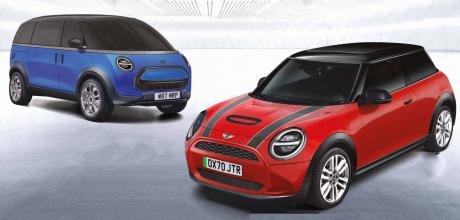Mini’s big EV charge
As Mini announces its green future will entail an emissions-free fleet from 2030, we sit down with brand boss Bernd Korber for the full rundown
Surprisingly candid is how we’d describe the head of Mini, Bernd Korber, who is speaking with Wheels about the brand’s bold future. He’s not hiding emotions, either. “We’ve got the next five years pretty much buttoned up,” he says, “but even thinking about the platform that will replace the [incoming EV] matrix introduced in 2023 is still spooky stuff right now”.
On paper, Mini is healthy. Impacted supply chains have knocked down a 2021 sales projection from 350,000 to 305,000, but that is still a five percent increase on the 292,000 cars sold last year. Ultimately, Mini is aiming for 500,000 annual sales, a goal expected in the decade’s second half.
Before then, big changes, like new factories in China and Germany that will assist a global debut of new and EV models, lay the groundwork for growth. In China, Mini will build two electric models in partnership with Great Wall Motors.
The first will arrive in 2023. Codenamed AO, the new EV will be a front-drive, three-door hatchback based on a bespoke Munich-developed platform. There also will be a brand new five-door zero-emission crossover in 2024. Think of a five-door Paceman with a less rakish roofline, all-wheel drive and large body-coloured grille ready to fight the Hyundai Kona.
In Leipzig, Germany, Mini will also build the next Countryman from 2023. It will offer electric and ICE powertrains on a common platform, presumably UKL-based, thanks to hardware from the BMW X1 and iX1.
“The plan is to market the Compact Utility Vehicle as a small electric-only crossover and to position the bigger third-generation Countryman SUV about half a notch above the current model,” Kerber adds. “Thanks to the modular layout, there should be no practical downside for either drivetrain option.”
As for the electric Mini built in China with GWM, Korber insists it will look very similar to the combustion engine Mini three-door, “because we won’t mess with our prime icon”.
“A Mini is a Mini,” he adds, “no matter whether it is battery or petrol powered”. It also suggests the current combustion engine Mini Cooper hatch (in convertible, three- and five-door guise) will simply continue until 2025. That year Mini will heavily redesign its UKL1 platform underpinning those combustion engine models, introducing what most likely will be the brand’s last combustion engine models before going all-electric in 2030.
As for Mini’s John Cooper Works performance sub-brand? “This is still a work in progress,” Korber admits. “We know for sure that JCW will eventually also go fully electric, but perhaps we should kick off one more truly radical project before the high voltage revolution strikes”.
Extracting more from the Mini JCW GP would be hard given its 2.0-litre turbocharged engine is already stretched to 228kW. However, electrification could realise something with a modest range and anywhere up to 300kW.
Before 2030, we also expect two all-new Mini models that will broaden the brand’s market segment coverage. The first is an ultra-compact EV hatch positioned under the three-door Mini, likely to eventually replace it.
Meanwhile, the other model replaces the Clubman with an interpretation of the brand’s Urbanaut people-mover concept, likely adopting the same sliding roadside door, lounge layout and interior packaging.
Korber also reveals more frequent exterior updates are on the way focused on Mini design trademarks. Think side scoops, wheels, stripes, roof treatment, tail-light graphics, toggle switches or seat patterns.
“All it takes to generate a fresh look are new colours, different materials like knit surfaces, mood changes by projection and special style packs,” says Korber.
Topping it all off will be “heritage-inspired or future-oriented” limited-edition specials. Mini is talking to external partners about coach-building specialised low-run collectibles.
They will feature unique exteriors, bespoke interiors, reworked engineering and might recreate icons like the Moke. They will also be expensive, but Mini says a market for such halo cars exists.
Beyond that, it’s too early to know if the AO will inspire an advanced second-generation EV architecture with autonomous driving or if that will underpin a BMW i1 or i2 – if they ever materialise.
Alternatively, Mini could tap into hardware from BMW’s incoming Neue Klasse EV range or further collaborate with Great Wall Motors. Whatever happens, for at least five years, the future looks bold and bright for Mini.
MINI MINI A smaller, true-to-roots Mini is on the way with electric power
BIG MINI This is how the next ‘Clubman’ could look based on concepts


